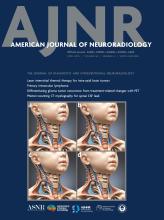This article requires a subscription to view the full text. If you have a subscription you may use the login form below to view the article. Access to this article can also be purchased.
Graphical Abstract
SUMMARY:
7T neuroimaging has known problems with B1+ strength, homogeneity and B0 susceptibility that make imaging in the inferior brain regions difficult. We investigated the utility of a decoupled 8 × 2 transceiver coil and shim insert to image the internal auditory canal (IAC) and inferior brain in comparison to the standard Nova 8/32 coil. B1+, B0, and the T2 sampling perfection with application-optimized contrasts by using flip angle evolution sequence (SPACE) were compared by using research and standard methods in n = 8 healthy adults by using a Terra system. A T2 TSE was also acquired, and 2 neuroradiologists evaluated structures in and around the IAC, blinded to the acquisition, by using a 5-point Likert scale. The Nova 8/32 coil gave lower B1+ inferiorly compared with the whole brain while the transceiver maintained similar B1+ throughout. SPACE images showed that the transceiver performed significantly better, e.g., the transceiver scored 4.0 ± 0.8 in the left IAC, compared with 2.5 ± 0.8 with the Nova 8/32. With T2-weighted imaging that places a premium on refocusing pulses, these results show that with improved B1+ performance inferiorly, good visualization of the structure of the IAC and inferior brain regions is possible at 7T.
ABBREVIATIONS:
- IAC
- internal auditory canal
- pTx
- parallel transmit
- RF
- radiofrequency
- SAR
- specific absorption rate
- SPACE
- sampling perfection with application-optimized contrasts by using flip angle evolution
- VHOS
- very high order B0 shim
- © 2025 by American Journal of Neuroradiology













